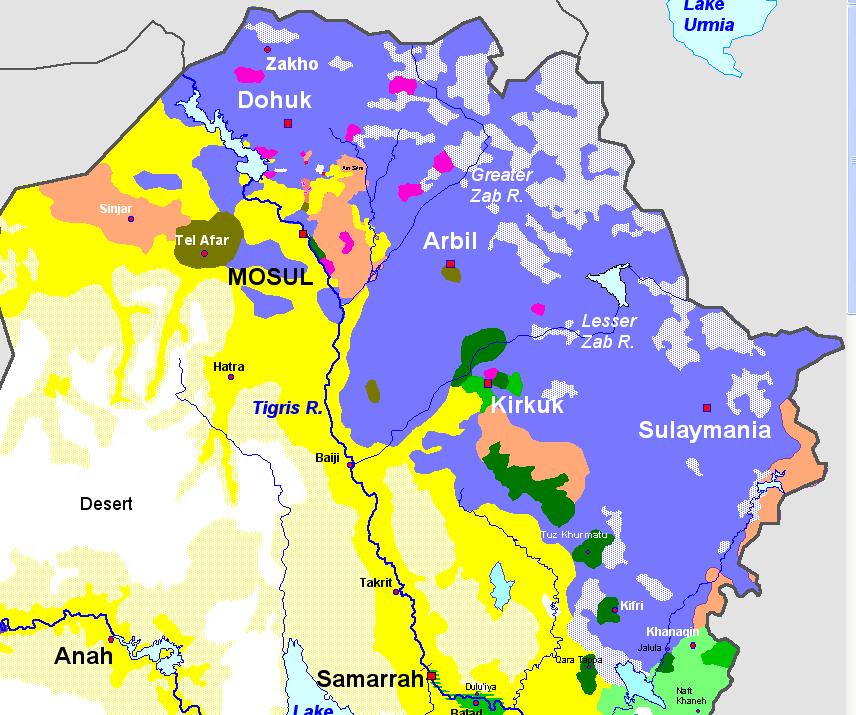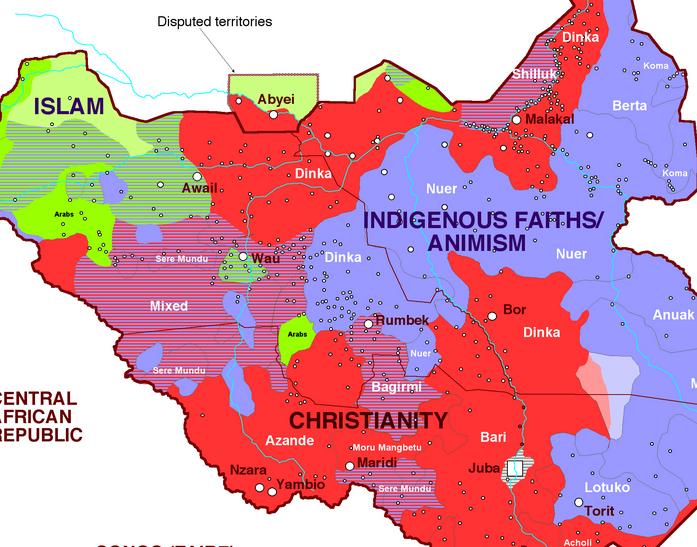The Maps of Michael Izady September 15, 2013
Author: Beach Combing | in : Actualite, Contemporary , trackback***Thanks to Stephen D for this one!!!***
Beach loves maps, who doesn’t? But he was sceptical about Michael Izady’s efforts until he actually went to take a look at the host site. Basically MI has set himself the task of charting ethnic, linguistic and religious groups in the Middle East. For most of us that would be ‘easy’: the answer is respectively Arab, Arabic and Muslim, isn’t it? But anyone who has spent even a little time in that corner of the world, will know that beneath the veneer, there is complexity, so much complexity, indeed, that the word ‘mosaic’ only begins to do it justice. For example, take religions in Iraq (map above). Iraq is not only ‘Muslim’ because it has both Sunni and Shia muslims, but it also has non Islamic religions that have somehow survived in the wildlands through generations. There are, in southern Iraq, the Sabbianites, which if Beach remembers correctly, are mentioned in the Koran as one of the peoples of the Book. There are various tiny groups of eastern Christians: Chaldians, Assyrians… who were taking Christ’s blood on their tongue while the English and their ancestors were still worshipping darker gods (see pink on the map or northern Iraq above). There are, then, the Yazdanis, a peculiar but endearing Gnostic religion – devil worshippers to many Muslims – that survives in wannabe Kurdistan again in the north of the country (orange on the map). It goes without saying that these non-Islamic minorities have suffered terribly since the Allied invasion, particularly outside of Kurdistan: having said that the Iraqis generally have not had a particularly rosy time either. The fragment below is from, instead, a religious map of Sudan: blue animistic, red Christian and green Islamic. No wonder there was a war or rather several wars! Of course, one of the problems for MI is that making a cartographic chart of religious or ethnic groups in such an unstable part of the world is particularly difficult because it is essentially a moving target. Every campaign sees a shift in people and the murder of others. Closer to home Northern Ireland and Yugoslavia, in Europe, have both seen massive shifts in population in the last half century (albeit on different timetables). It seems that we are, in some respects, less good at living side by side with difference than our medieval ancestors: a dominant culture absorbs outsiders, two or three ‘dominant’ cultures will be at each other’s throats if they live side by side. Why? drbeachcombing AT yahoo DOT com Human nature has not got worse, perhaps what our medieval forebears lacked was not nastiness but power.
19: Sept 2013: Couple of fascinating pieces on this. First, Louis: I think this is because of Education, mass media and Nation Building, and wanting to kill all the pesky guys that remind you of the bad old days, when they were not in charge. Not that they are now, but there also is no Lord of the land. In the “old days”, when the lord of the land said that this or that group was to be protected (or killed), then you better did that, or else there were consequences. Combined with what your ideas are about how your country should look like (religion, skin, language, and yhe others do not fit here) and how they are pushed by the mass media, and the educational services. In this day and age there are not many lords any more, but when they do go, there is a scramble for first place, and the will to get rid of the unprotected. Witness the land grabbing and genocide that happened after the last Lord of Yugoslavia (one Josip Broz, obit 1980) died. In the same way mister Hussein was the big boss that, more or less, protected all those small groups in Iraq, because they were not big enough to be a threat, but useful as fall guys, when something bad happened. In Southern Sudan it is more like united until the birth of the nation, and now fighting to see who becomes top dog. And who gets all that oil money. Always a powerful incentive to fight for, and declare somebody “not wanted here” because of skin, religion or language difference. In a way most Western European regions went through the same thing, and by dint of language, politics, and strategic marriages, coalesced in the nations that they are now. And already, now that Brussels has weakened the national bonds that holds them together, they are slowly starting to drift apart again. All sorts of regions not being happy with what is done in their own capitals, and believing that they can do better with more autonomy, directly under the EU, are taking steps in that direction, including defining what is a “proper” person from that region. Some of them quit militantly.’ Then EC: In my view at least two factors contribute to this phenomenon: 1) Modern means of communication, which put images of the “other” in front of people in a way unknown to earlier societies. If I greet my neighbor of another ethnicity in the market but go home to my neighborhood and spend most of my time with my people, I will be unruffled by the other’s proximity. Out of sight, etc. 2) Modernity in general, which is an alkahest for tradition, as the Communist Manifesto points out. If I feel my culture dissolving, which is a deeply existential threat, I will look for scapegoats and lash out at them. See: Weimar Germany, among many, many others. In addition access to resources are often at the basis of conflicts superficially of an ethnic or religious character, so while the jobless Middle Easterners are at one another’s throats, the comfortably jowly Midwesterners (Iowa etc.) are fairly tolerant of immigrants in their midst. I would further suggest that it’s difficult to say with confidence whether and to what degree levels of intolerance have changed over time. It’s not difficult to find examples of intense ethnic conflict in almost any period of history: to pick one example.’ Thanks EC and Louis!
20 Sept 2013: Stephen D writes, one of the factors in allowing a mosaic of different communities to form was, I think, the existence of a government which was not too concerned about ethnicity. Under Ottoman rule, the important thing about the peoples of Iraq, Synia, Lebanon, Palestine was not their race or religion, but their acceptance of “Turkish” administrators (several of whom were not themselves Turkish at all). Another case would be the Austro-Hungarian empire. I attach a map, pre Big Mistake I, of the ethnic composition of the kingdom of Hungary. NB that (a) the odd angular shapes represent the ethnic composition of cities, but not the areas covered by them (b) the ethnonyms are mostly in Hungarian, and some are not obvious. Tots = Slovaks, Wallachians = Romanians, Races = Orthodox Serbs, Horvats = Croats, Bunyevaces = Catholic Serbs, Vends = Slovenes, Lengyels = Poles. Thanks Stephen!





